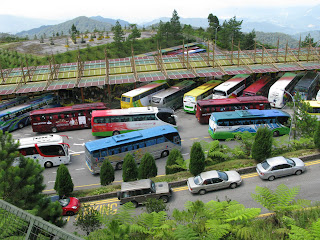Royal Selangor Pewter Factory
 One of the resources Malaysia has is tin. Pewter used to be made from
tin and lead but they stopped using lead a while ago because it is
poisonous. These days, pewter is made from Tin, Antimony and Copper.
One of the resources Malaysia has is tin. Pewter used to be made from
tin and lead but they stopped using lead a while ago because it is
poisonous. These days, pewter is made from Tin, Antimony and Copper.The tour of the pewter factory is free. They will even pick you up from your hotel and drop you back. The car that picked us up from the hotel was actually empty and it was just us. The driver said his name is Dayalan. He was such an excellent driver and the drive to the pewter factory was actually like a personal guided tour of Malaysia as he provided commentary of the sights along the route. He said he would also be the one sending us back to the hotel afterwards and gave us a time to meet him.
 There was a guided tour of the factory. It started with some of the history of pewter. The sultan of Selangor (a province in Malaysia) endorsed the pewter and that is why it is called "Royal Selangor Pewter".
There was a guided tour of the factory. It started with some of the history of pewter. The sultan of Selangor (a province in Malaysia) endorsed the pewter and that is why it is called "Royal Selangor Pewter".Pewter was an early form of money and used to be cast into a money tree. Coins broken off to pay for goods and services.
The guide was talking about the "twin towers made of pewter mugs"... my comment was "dont you mean the tin towers?" referring to the fact that pewter is mostly tin. But nobody laughed at my joke =(
 |
| Molten pewter |
 |
| Polishing the shell |
 |
| Adding the design |
 |
| Adding the base |
 |
| Intricate designs |
There are a couple of walls at the factory decorated with hands. Each one of these belongs to a person who works at the factory. After 5 years of continuous service, the company rewards loyalty by having your hand cast and displayed on the walls.
Our guide was able to show us his hand. He has been working for Royal Selangor Pewter for 28 years now.
 | |
| Our driver Dayalan's hand cast. |
 |
Selangor Pewter is used in many trophys for sporting events such at the Malaysian F1 and ATP Shanghai tennis

























